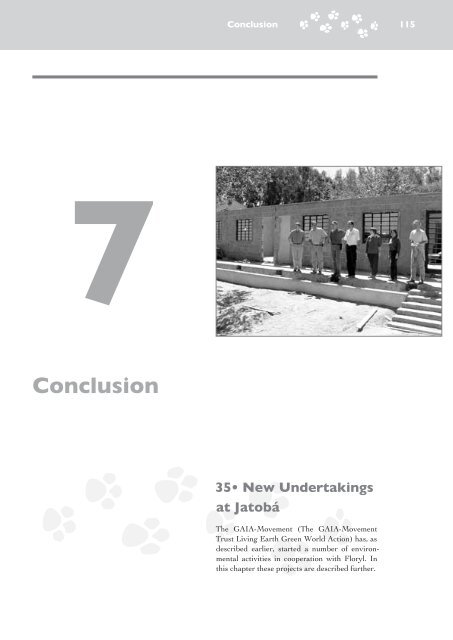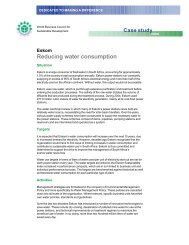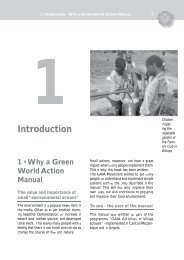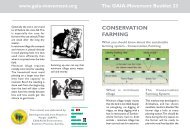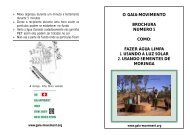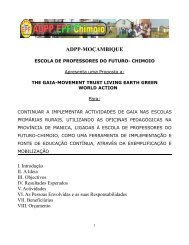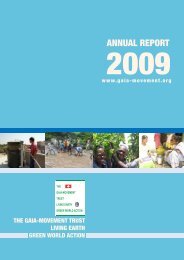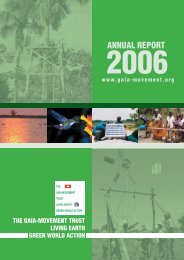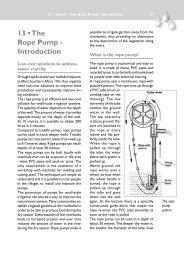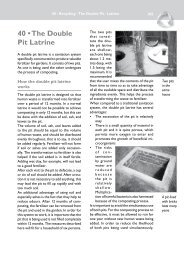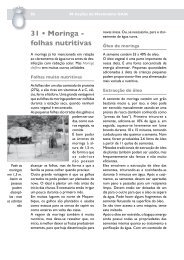Conclusion (including presentation of the GAIA-Movement project at ...
Conclusion (including presentation of the GAIA-Movement project at ...
Conclusion (including presentation of the GAIA-Movement project at ...
Create successful ePaper yourself
Turn your PDF publications into a flip-book with our unique Google optimized e-Paper software.
7<br />
<strong>Conclusion</strong><br />
<strong>Conclusion</strong><br />
35• New Undertakings<br />
<strong>at</strong> J<strong>at</strong>obá<br />
The <strong>GAIA</strong>-<strong>Movement</strong> (The <strong>GAIA</strong>-<strong>Movement</strong><br />
Trust Living Earth Green World Action) has, as<br />
described earlier, started a number <strong>of</strong> environmental<br />
activities in cooper<strong>at</strong>ion with Floryl. In<br />
this chapter <strong>the</strong>se <strong>project</strong>s are described fur<strong>the</strong>r.<br />
115
Pine trees are<br />
planted in <strong>the</strong><br />
soy field in a<br />
so-called agr<strong>of</strong>orestry<br />
system<br />
116 <strong>Conclusion</strong><br />
Agro-forestry trials combining soy<br />
and energy trees<br />
The objective <strong>of</strong> <strong>the</strong>se trials is to find <strong>the</strong> best way<br />
<strong>of</strong> growing energy trees toge<strong>the</strong>r with soy. The<br />
trees will benefit from <strong>the</strong> soil prepar<strong>at</strong>ion th<strong>at</strong><br />
<strong>the</strong> soy field receives, and also from <strong>the</strong> increased<br />
amount <strong>of</strong> organic m<strong>at</strong>ter and nutrients containing<br />
nitrogen th<strong>at</strong> <strong>the</strong> root bacteria produce.<br />
A soy field <strong>of</strong> 50 ha has been prepared. The<br />
soil was given lime in <strong>the</strong> beginning <strong>of</strong> 2003, and<br />
soil tests in July 2004 showed th<strong>at</strong> it no longer<br />
had poisonous levels <strong>of</strong> aluminium. The eucalyptus<br />
and pine trees were planted on five hectares <strong>of</strong><br />
<strong>the</strong> soy field in January 2004, in rows spaced 10<br />
meter apart. This<br />
gives 300 trees/<br />
ha, as opposed<br />
to 1666 trees/ha<br />
in normal plant<strong>at</strong>ions.<br />
On better<br />
soils in <strong>the</strong> st<strong>at</strong>e <strong>of</strong><br />
Minas Gerais <strong>the</strong>y<br />
have obtained an<br />
annual growth <strong>of</strong><br />
35 m 3 /ha with <strong>the</strong><br />
agro-forestry system,<br />
compared<br />
to 45 m 3 /ha with<br />
monocultures (only eucalyptus). The individual<br />
trees develop better, and <strong>the</strong>refore become more<br />
valuable since more sawn products are possible.<br />
Fur<strong>the</strong>rmore, one has <strong>the</strong> advantage <strong>of</strong> an agricultural<br />
crop between <strong>the</strong> trees.<br />
Various kinds <strong>of</strong> energy trees are tested: three<br />
different kinds <strong>of</strong> eucalyptus hybrids (crosses between<br />
E. grandis and E. urophylla, E. grandis × E.<br />
camaldulensis and E. urophylla × E. camaldulensis).<br />
Pine trees <strong>of</strong> <strong>the</strong> species Pinus caribaea hondurensis<br />
are also grown.<br />
The seedlings for this year’s trials have been produced<br />
<strong>at</strong> ano<strong>the</strong>r nursery. The nursery <strong>at</strong> Vila<br />
J<strong>at</strong>obá has been restored and is ready for production<br />
<strong>of</strong> tree seedlings for <strong>the</strong> coming seasons.<br />
The idea is also to expand <strong>the</strong> trials to test o<strong>the</strong>r<br />
energy trees as well.<br />
One species <strong>of</strong> acacia seems to grow well on<br />
<strong>the</strong> better soils <strong>of</strong> J<strong>at</strong>obá, and since it gives good<br />
quality timber as well as biomass for energy, it<br />
will be good to test it. Local cerrado species <strong>of</strong><br />
<strong>the</strong> legume family will also be tried, as well as<br />
traditional energy trees such as Leucaena. They<br />
have earlier been tested <strong>at</strong> J<strong>at</strong>obá, but not on soil<br />
where acidity and aluminium content has been<br />
corrected with lime.<br />
Ano<strong>the</strong>r part <strong>of</strong> <strong>the</strong>se trials is to determine <strong>the</strong> optimal<br />
start conditions for <strong>the</strong> eucalyptus trees.<br />
This takes place <strong>at</strong> a former test plot for sugar<br />
cane between <strong>the</strong> industries and Vila J<strong>at</strong>obá. It<br />
has not been used for many years, and <strong>the</strong> first task<br />
is to cut down <strong>the</strong> small trees th<strong>at</strong> have grown up.<br />
The system <strong>of</strong> minimum tillage is used where<br />
<strong>the</strong> soil is not ploughed, and <strong>the</strong> soil is kept covered<br />
as much as possible with plant residues.<br />
Half <strong>of</strong> <strong>the</strong> field was prepared, using <strong>the</strong> contact<br />
herbicide Round-up, which kills <strong>the</strong> living<br />
plants. This is widely used in Brazil’s many soy<br />
fields grown with minimum tillage.<br />
The o<strong>the</strong>r half <strong>of</strong> <strong>the</strong> field was cut down mechanically<br />
with a slasher, placed behind a tractor.<br />
During <strong>the</strong> first years <strong>the</strong> weeds between <strong>the</strong><br />
tree rows will be kept down by slashing.<br />
Two different eucalyptus varieties are tested<br />
here. High yielding clones <strong>of</strong> <strong>the</strong> hybrid grancam,<br />
developed by <strong>the</strong> CMM company (see l<strong>at</strong>er).<br />
And <strong>the</strong> hybrid urograndis, which is <strong>the</strong> one<br />
mostly used on nutrient poor cerrado soils.<br />
They are planted in plant holes – 30 × 30 × 30 cm<br />
– filled with one <strong>of</strong> <strong>the</strong> compositions below:<br />
• Soil from <strong>the</strong> field + normal type and amount<br />
<strong>of</strong> fertilizer<br />
• Soil from <strong>the</strong> former soy field + fertilizer<br />
• Compost made from <strong>the</strong> wood residues + fertilizer<br />
• Soil from <strong>the</strong> former soy field mixed with compost<br />
+ fertilizer<br />
These trials will test <strong>the</strong> effect <strong>of</strong> <strong>the</strong> compost<br />
th<strong>at</strong> is being produced from <strong>the</strong> wood residues <strong>at</strong><br />
J<strong>at</strong>obá’s industries. They will also show whe<strong>the</strong>r<br />
<strong>the</strong> soil from <strong>the</strong> former soy field, where eucalyptus<br />
is growing well, has an effect on <strong>the</strong> development<br />
<strong>of</strong> <strong>the</strong> small seedlings. If it has, it could ei<strong>the</strong>r<br />
be because <strong>of</strong> some special microorganisms<br />
or some physical or chemical properties.
Cloned eucalyptus<br />
J<strong>at</strong>obá has made an agreement with a large cement<br />
and mining company th<strong>at</strong> also has large<br />
plant<strong>at</strong>ions in Minas Gerais – CMM (Companhia<br />
Mineira de Metais). They have developed an<br />
agro-forestry system <strong>of</strong> soy and eucalyptus during<br />
<strong>the</strong> last 9 years. They also have a good system<br />
for selection and production <strong>of</strong> eucalyptus clones,<br />
for example selecting trees where <strong>the</strong> timber can<br />
be used for saw milling. The agreement is th<strong>at</strong><br />
some <strong>of</strong> <strong>the</strong>ir clones are tested under <strong>the</strong> harsh<br />
conditions <strong>of</strong> J<strong>at</strong>obá – also grown toge<strong>the</strong>r with<br />
soybeans.<br />
The nursery <strong>at</strong> CMM is also making clones from<br />
plant m<strong>at</strong>erial, taken from <strong>the</strong> best eucalyptus<br />
clones <strong>at</strong> J<strong>at</strong>obá (selected and multiplied when<br />
Shell was <strong>the</strong> owner). They keep half <strong>of</strong> <strong>the</strong>se, so<br />
th<strong>at</strong> <strong>the</strong>y can test <strong>the</strong>m under <strong>the</strong>ir conditions,<br />
and J<strong>at</strong>obá receives <strong>the</strong> o<strong>the</strong>r half. Some <strong>of</strong> <strong>the</strong>se<br />
are tested in <strong>the</strong> agro-forestry system with soy,<br />
and some will be used to establish cloning m<strong>at</strong>erial<br />
<strong>at</strong> <strong>the</strong> nursery, so th<strong>at</strong> J<strong>at</strong>obá can produce<br />
<strong>the</strong>se clones in <strong>the</strong> future.<br />
Nursery and arboretum with<br />
production <strong>of</strong> energy trees, cerrado<br />
trees and medicinal plants<br />
A part <strong>of</strong> <strong>the</strong> <strong>project</strong> is to start a production <strong>of</strong><br />
<strong>the</strong> best pine and eucalyptus varieties <strong>at</strong> J<strong>at</strong>obá’s<br />
nursery. Shell planted many varieties <strong>of</strong> <strong>the</strong>se<br />
trees, and <strong>the</strong> task is now to collect <strong>the</strong> seeds and<br />
plant m<strong>at</strong>erial from <strong>the</strong> best varieties, in order to<br />
multiply <strong>the</strong> ones th<strong>at</strong> are best suited for <strong>the</strong> conditions<br />
<strong>at</strong> J<strong>at</strong>obá. Pinus tecunumanii is not common<br />
in Brazil, and it is <strong>the</strong>refore important to<br />
multiply <strong>the</strong> best <strong>of</strong> <strong>the</strong>se. They had no cones in<br />
2003 (this happens with pine trees), and time will<br />
show whe<strong>the</strong>r <strong>the</strong>re are any in 2004.<br />
Seeds have been collected from <strong>the</strong> special eucalyptus<br />
varieties <strong>of</strong> E. urophylla th<strong>at</strong> Shell had obtained<br />
from collections on various Indonesian islands.<br />
They will be planted in 2004.<br />
<strong>Conclusion</strong><br />
117<br />
Particip<strong>at</strong>ion in resin research<br />
J<strong>at</strong>obá has started system<strong>at</strong>ic measurements <strong>of</strong><br />
<strong>the</strong> resin production from 20 different pine varieties.<br />
This will show which varieties produce <strong>the</strong><br />
most, and J<strong>at</strong>obá can l<strong>at</strong>er harvest seeds from<br />
<strong>the</strong>se and multiply <strong>the</strong>m.<br />
J<strong>at</strong>obá also particip<strong>at</strong>es in research organized<br />
by <strong>the</strong> n<strong>at</strong>ional resin producers’ associ<strong>at</strong>ion,<br />
ARESB. The aim is to select <strong>the</strong> best resin producing<br />
pine varieties, and <strong>the</strong>n to develop a simple<br />
method <strong>of</strong> propag<strong>at</strong>ing <strong>the</strong>se through cloning.<br />
The varieties <strong>the</strong>y have chosen are probably not<br />
suited for <strong>the</strong> conditions <strong>at</strong> J<strong>at</strong>obá, since <strong>the</strong> o<strong>the</strong>r<br />
resin areas have better soil and more rain. But<br />
it is good for J<strong>at</strong>obá to take part in this research<br />
and learn <strong>the</strong> cloning technique. This can <strong>the</strong>n be<br />
used on <strong>the</strong> best producing trees <strong>at</strong> J<strong>at</strong>obá. The<br />
cloned trees will have <strong>the</strong> same genes as <strong>the</strong> selected<br />
mo<strong>the</strong>r<br />
trees (selected<br />
among <strong>the</strong> 40<br />
million trees <strong>at</strong><br />
J<strong>at</strong>obá). They<br />
thus have a<br />
much gre<strong>at</strong>er<br />
chance <strong>of</strong> surviving<br />
<strong>the</strong> acid<br />
soils and <strong>the</strong><br />
long dry season.<br />
Multiplic<strong>at</strong>ion<br />
<strong>of</strong> eucalyptus<br />
<strong>at</strong> CMM is<br />
carried out by<br />
taking cuttings<br />
from this clonal<br />
garden
The arboretum<br />
<strong>of</strong> J<strong>at</strong>obá consist<br />
<strong>of</strong> newly planted<br />
cerrado trees,<br />
and <strong>the</strong> older<br />
trees already<br />
<strong>the</strong>re<br />
The <strong>GAIA</strong> post<br />
by <strong>the</strong> river tells<br />
about its special<br />
plants and<br />
animals<br />
118 <strong>Conclusion</strong><br />
The arboretum <strong>at</strong> J<strong>at</strong>obá<br />
The <strong>GAIA</strong> <strong>project</strong> has established an arboretum<br />
<strong>at</strong> Vila J<strong>at</strong>obá with a collection <strong>of</strong> <strong>the</strong> common<br />
cerrado trees and shrubs, so th<strong>at</strong> people can get<br />
to know <strong>the</strong> local<br />
plants. Many <strong>of</strong><br />
<strong>the</strong>se have medical<br />
uses, and <strong>the</strong><br />
aim is also to get<br />
experience with<br />
how to produce<br />
<strong>the</strong>m – which<br />
ones can be<br />
grown from seeds<br />
and which ones<br />
from cuttings.<br />
Experiments<br />
will be carried out<br />
to improve <strong>the</strong> living conditions <strong>of</strong> some medicinal<br />
plants in <strong>the</strong>ir n<strong>at</strong>ural surroundings in order<br />
to have more <strong>of</strong> <strong>the</strong>m. This is for example done by<br />
thinning if <strong>the</strong>y are too close, weeding around <strong>the</strong><br />
seedlings, removing unwanted trees, etc.<br />
At least 20 <strong>of</strong> <strong>the</strong> common plants found in <strong>the</strong><br />
cerrado <strong>at</strong> J<strong>at</strong>obá have medicinal uses.<br />
The aim <strong>of</strong> this part <strong>of</strong> <strong>the</strong> <strong>project</strong> is to demonstr<strong>at</strong>e<br />
one more reason for preserving <strong>the</strong> cerrado<br />
veget<strong>at</strong>ion.<br />
One <strong>of</strong> <strong>the</strong> medical plants <strong>of</strong> <strong>the</strong><br />
cerrado<br />
The cerrado with its estim<strong>at</strong>ed 10,000 plant species<br />
is a veritable gold mine <strong>of</strong> chemical compounds,<br />
<strong>of</strong> which only a tiny fraction have been<br />
investig<strong>at</strong>ed.<br />
One <strong>of</strong> <strong>the</strong><br />
trees th<strong>at</strong> are being<br />
used commercially<br />
in Brazil is<br />
Fava d’Anta (<strong>the</strong><br />
tapir pod). The<br />
large pods and <strong>the</strong><br />
bark are used to<br />
extract substances<br />
for <strong>the</strong> health<br />
industry. They<br />
contain 8 % so-<br />
called bi<strong>of</strong>lavanoids, rutina and quercetin, which<br />
function toge<strong>the</strong>r with vitamin C in streng<strong>the</strong>ning<br />
<strong>the</strong> smallest blood vessels, <strong>the</strong> capillaries. This is<br />
important in order to avoid blood clots.<br />
Three factories in Brazil produce <strong>the</strong>se finished<br />
products, and toge<strong>the</strong>r with China <strong>the</strong> country<br />
domin<strong>at</strong>es <strong>the</strong> world market. In 1996 Brazil exported<br />
$12 million worth. The market is rising,<br />
and until now <strong>the</strong>re is not sufficient to cover <strong>the</strong><br />
annual requirement <strong>of</strong> 2,000 tons.<br />
The trees are not grown commercially, but <strong>the</strong><br />
pods are collected by families who <strong>the</strong>n sell <strong>the</strong>m<br />
<strong>at</strong> a very low price. The middlemen earn a larger<br />
part, and <strong>the</strong>y are sold <strong>at</strong> <strong>the</strong> factory for about<br />
0.15 $/kg. 1<br />
Trials will be started <strong>at</strong> J<strong>at</strong>obá to increase <strong>the</strong><br />
number <strong>of</strong> <strong>the</strong>se trees in a specific cerrado area,<br />
in order to investig<strong>at</strong>e whe<strong>the</strong>r an actual production<br />
<strong>of</strong> <strong>the</strong>se substances is viable.<br />
The <strong>GAIA</strong> centre and <strong>the</strong><br />
<strong>GAIA</strong> st<strong>at</strong>ions<br />
The aim <strong>of</strong> <strong>the</strong> <strong>GAIA</strong> st<strong>at</strong>ions is to make <strong>the</strong> environmental<br />
<strong>project</strong> visible and public. In th<strong>at</strong><br />
way guests, employees, school children from <strong>the</strong><br />
region, school camps and tourists can come to<br />
J<strong>at</strong>obá and learn about <strong>the</strong> many aspects <strong>of</strong> <strong>the</strong><br />
<strong>project</strong>. 12 posters with pictures and texts have<br />
been printed and lamin<strong>at</strong>ed and have been placed<br />
under shelters in <strong>the</strong> area – by <strong>the</strong> river, <strong>at</strong> <strong>the</strong><br />
power plants, <strong>the</strong> fire tower, <strong>the</strong> large reserve,<br />
<strong>the</strong> permanent measuring plots, <strong>the</strong> view point<br />
over <strong>the</strong> river. They deal with issues such as <strong>the</strong><br />
history, <strong>the</strong> veget<strong>at</strong>ion, <strong>the</strong> resin production, <strong>the</strong><br />
thinning, <strong>the</strong> comb<strong>at</strong>ing <strong>of</strong> fires and ants, <strong>the</strong> soil,<br />
animal tracks, etc.<br />
The <strong>GAIA</strong> centre lies by <strong>the</strong> river <strong>at</strong> Vila J<strong>at</strong>obá.<br />
It is a place where guests can come and use it as a<br />
base for n<strong>at</strong>ure studies <strong>of</strong> <strong>the</strong> farm’s area.<br />
Here <strong>the</strong> zoologists can bring back <strong>the</strong>ir c<strong>at</strong>ch<br />
<strong>of</strong> small mammals and under good conditions<br />
study <strong>the</strong>m fur<strong>the</strong>r, measure and mark <strong>the</strong>m, etc.,<br />
before releasing <strong>the</strong>m again.<br />
Insects and any dead animals found can be<br />
tre<strong>at</strong>ed with <strong>the</strong> correct chemicals, so th<strong>at</strong> <strong>the</strong>y<br />
can be preserved.
Where we are standing, it is possible to look down<br />
in <strong>the</strong> valley with <strong>the</strong> Arrojado River <strong>at</strong> <strong>the</strong> bottom.<br />
The river has carved this huge valley. This shows th<strong>at</strong><br />
it must have been over a long period <strong>of</strong> time. It is assumed<br />
th<strong>at</strong> <strong>the</strong> rivers in this region have been formed<br />
when <strong>the</strong> whole region was folded and lifted up. On<br />
a map one can see th<strong>at</strong> all <strong>the</strong> rivers run parallel to<br />
each o<strong>the</strong>r towards nor<strong>the</strong>ast. They have about <strong>the</strong><br />
same distance between <strong>the</strong>m. The crust <strong>of</strong> <strong>the</strong> earth<br />
has formed some giant waves, and <strong>the</strong> rivers have developed<br />
in <strong>the</strong> bottom <strong>of</strong> <strong>the</strong>se waves. Over time <strong>the</strong>y<br />
have dug fur<strong>the</strong>r and fur<strong>the</strong>r down, and after 600 million<br />
years <strong>the</strong> result is <strong>the</strong>se river valleys.<br />
Fur<strong>the</strong>r down one finds dark limestone. They come to<br />
surface only <strong>at</strong> few places on J<strong>at</strong>obá – more <strong>of</strong> <strong>the</strong>se<br />
rocks are found around Posse. On top <strong>of</strong> this limestone<br />
<strong>the</strong>re is a thick layer <strong>of</strong> sandstone. They are <strong>the</strong><br />
ones in front <strong>of</strong> us, and make up most <strong>of</strong> <strong>the</strong> m<strong>at</strong>erial in<br />
<strong>the</strong> pl<strong>at</strong>eau. This layer has been formed during <strong>the</strong> last<br />
600 million years. For periods <strong>the</strong> area has been under<br />
w<strong>at</strong>er, and sand has been deposited <strong>at</strong> <strong>the</strong> bottom.<br />
During o<strong>the</strong>r periods sand has blown in from neighbouring<br />
areas. This m<strong>at</strong>erial has been pressed toge<strong>the</strong>r<br />
and turned into sandstone. The top layer <strong>of</strong> <strong>the</strong> pl<strong>at</strong>eau<br />
is a thick sand layer.<br />
Until 200 million years ago South America was <strong>at</strong>tached<br />
to Africa, Australia and Antarctica. This continent,<br />
Gondwanaland, was split up, and South America started<br />
its journey north, where it joined with Central America<br />
three million years ago. The first mammals had evolved<br />
when <strong>the</strong> continent split up, and in South America <strong>the</strong>y<br />
evolved in a different direction than in <strong>the</strong> rest <strong>of</strong> <strong>the</strong><br />
world. Especially <strong>the</strong> order <strong>of</strong> mammals called edent<strong>at</strong>es<br />
(without teeth) evolved into large mammals such<br />
as giant ante<strong>at</strong>ers, armadillos and sloth’s. Herbivores<br />
(plant e<strong>at</strong>ers) rel<strong>at</strong>ed to elephants and hippos, with a<br />
weight up to 4 tons, wandered around on <strong>the</strong> open cerrado<br />
areas. As opposed to <strong>the</strong> African savannahs, <strong>the</strong>re<br />
were no fast pred<strong>at</strong>ors, and it was <strong>the</strong>refore not necessary<br />
to evolve into a fast runner to avoid being e<strong>at</strong>en.<br />
N<strong>at</strong>ural enemies only appeared on <strong>the</strong> scene when <strong>the</strong><br />
large c<strong>at</strong>s were able to come to South America, three<br />
million years ago. But it was when humans came to <strong>the</strong><br />
cerrado areas about 9,000 years ago, th<strong>at</strong> <strong>the</strong> animals<br />
were wiped out definitely. 10,000 years ago <strong>the</strong>re were<br />
still 60 animal genera (group <strong>of</strong> closely rel<strong>at</strong>ed animals)<br />
with animals over 44 kg. Today only 13 remain. There<br />
were 10 genera with animals over 1 ton, where none<br />
remain today. This was partly because man had developed<br />
<strong>the</strong> use <strong>of</strong> fire against <strong>the</strong>se large animals. 2<br />
O Movimento <strong>GAIA</strong><br />
Fazenda J<strong>at</strong>obá<br />
Posto 6: A História<br />
<strong>Conclusion</strong><br />
119<br />
At J<strong>at</strong>obá one can still find tracks <strong>of</strong> <strong>the</strong> Indians who<br />
lived here, maybe thousands <strong>of</strong> years ago. As mentioned<br />
earlier, <strong>the</strong>y did not develop agriculture – partly<br />
because <strong>the</strong> leaf cutting ants are so efficient in destroying<br />
new plants. They lived <strong>of</strong>f hunting, fishing and<br />
collection <strong>of</strong> roots and fruits. We can see this in some<br />
caves fur<strong>the</strong>r down by <strong>the</strong> Arrojado River. Here are<br />
drawings <strong>of</strong> seriema tracks, <strong>the</strong> long-legged “roadrunner”.<br />
We do not know when <strong>the</strong>se drawings <strong>of</strong> bird<br />
tracks d<strong>at</strong>e from. But <strong>the</strong> first people in <strong>the</strong> cerrado<br />
region – <strong>the</strong> Itaparica tradition from 9,000 years<br />
ago – made such animal drawings and collected roots<br />
and fruits. 6,500 years ago <strong>the</strong>y were replaced with<br />
ano<strong>the</strong>r group <strong>of</strong> people who<br />
caught smaller mammals and<br />
collected snails and shellfish. It<br />
is not known why this change<br />
happened, but maybe because<br />
<strong>the</strong> big animals had been<br />
wiped out.<br />
None <strong>of</strong> <strong>the</strong>se Indians are<br />
left on <strong>the</strong> cerrado. They have<br />
probably succumbed, as so<br />
many o<strong>the</strong>r Indian tribes, to<br />
<strong>the</strong> diseases brought by <strong>the</strong><br />
Europeans, against which <strong>the</strong>y<br />
had no resistance.<br />
During <strong>the</strong> centuries after <strong>the</strong><br />
arrival <strong>of</strong> <strong>the</strong> Europeans, not<br />
very much happened in Central<br />
Brazil. There were some<br />
c<strong>at</strong>tle farming and a few small<br />
farmers. This picture only<br />
changed when <strong>the</strong> government<br />
decided to open up <strong>the</strong><br />
area, and supported <strong>the</strong> clearing <strong>of</strong> cerrado to establish<br />
extensive pastures and soy fields. At <strong>the</strong> same time<br />
<strong>the</strong> research institute, EMBRAPA, had developed <strong>the</strong><br />
soil tre<strong>at</strong>ment systems and grass and soy varieties, so<br />
th<strong>at</strong> <strong>the</strong>y could grow in <strong>the</strong> special cerrado soil.<br />
When Floryl established <strong>the</strong> first plant<strong>at</strong>ions <strong>at</strong> J<strong>at</strong>obá<br />
in 1981, <strong>the</strong>re were hardly any soy fields for 300 km<br />
north to Barreiras. The s<strong>at</strong>ellite photos from th<strong>at</strong> time<br />
show very few cultiv<strong>at</strong>ed areas.<br />
The s<strong>at</strong>ellite photo from 2004 shows how practically<br />
all <strong>the</strong> cultivable land between J<strong>at</strong>obá and Barreiras<br />
now has been transformed into soy fields and<br />
pastures.<br />
THE<br />
<strong>GAIA</strong>-MOVEMENT<br />
TRUST<br />
LIVING EARTH<br />
GREEN WORLD ACTION<br />
The text from<br />
one <strong>of</strong> <strong>the</strong> <strong>GAIA</strong><br />
st<strong>at</strong>ions<br />
The subsoil <strong>at</strong><br />
J<strong>at</strong>obá consists<br />
<strong>of</strong> very old sand<br />
stone
The <strong>GAIA</strong> centre<br />
is a base for<br />
research teams<br />
and school<br />
classes for<br />
<strong>the</strong>ir studies <strong>of</strong><br />
J<strong>at</strong>obá’s n<strong>at</strong>ure<br />
Thoralf shows<br />
some <strong>of</strong> J<strong>at</strong>obá’s<br />
insects th<strong>at</strong> are<br />
exhibited <strong>at</strong> <strong>the</strong><br />
<strong>GAIA</strong> centre<br />
120 <strong>Conclusion</strong><br />
There are stereo magnifying glasses to study insects<br />
and plant parts, and microscopes to study<br />
<strong>the</strong> finer details.<br />
There are<br />
large maps <strong>of</strong> <strong>the</strong><br />
area, and copies<br />
where <strong>the</strong> researchers<br />
can plot<br />
<strong>the</strong>ir finds and results.<br />
The botanists<br />
have space<br />
for pressing <strong>the</strong><br />
plants, and <strong>the</strong>y<br />
can make soil<br />
tests, where <strong>the</strong><br />
grain size and amount <strong>of</strong> organic m<strong>at</strong>ter can be<br />
determined. There is a drying oven and scales for<br />
this use.<br />
The centre is base for <strong>the</strong> research teams with<br />
space for studies and meetings. It accommod<strong>at</strong>es<br />
12 persons with kitchen and b<strong>at</strong>hrooms.<br />
One <strong>of</strong> <strong>the</strong> rooms in <strong>the</strong> <strong>GAIA</strong> centre is <strong>the</strong><br />
N<strong>at</strong>ural Museum <strong>of</strong> J<strong>at</strong>obá. Here we find <strong>the</strong><br />
various objects found by <strong>the</strong> people working in<br />
<strong>the</strong> forest. There are antlers from <strong>the</strong> small deer,<br />
<strong>the</strong> skull <strong>of</strong> a caititu, <strong>the</strong> local wild boar, or <strong>the</strong><br />
shield <strong>of</strong> an armadillo.<br />
Here is also an exhibition <strong>of</strong> <strong>the</strong> various fruits,<br />
seeds, insect and stones. There are photos from<br />
special places <strong>at</strong> J<strong>at</strong>obá,<br />
such as <strong>the</strong> historic cave<br />
drawings, or <strong>the</strong> large<br />
fossil in <strong>the</strong> river.<br />
On <strong>the</strong> walls are s<strong>at</strong>ellite<br />
photos from <strong>the</strong> past<br />
and <strong>the</strong> present, air photos<br />
and photos <strong>of</strong> some <strong>of</strong><br />
<strong>the</strong> special birds and animals<br />
found here.<br />
A large map with coloured<br />
needles and d<strong>at</strong>es<br />
show where and when<br />
<strong>the</strong> more rare animals<br />
were last seen – such<br />
as tapir, ante<strong>at</strong>er, wolf,<br />
puma, black and spotted<br />
jaguar and nandu.<br />
Tables show <strong>the</strong> st<strong>at</strong>istics <strong>of</strong> <strong>the</strong> wildlife observ<strong>at</strong>ions<br />
from <strong>the</strong> two fire towers.<br />
O<strong>the</strong>r tables show <strong>the</strong> w<strong>at</strong>er level <strong>of</strong> <strong>the</strong> two rivers<br />
during <strong>the</strong> dry months. This is measured every<br />
14 days, and <strong>the</strong> temper<strong>at</strong>ure and <strong>the</strong> rainfall<br />
are measured in four places on <strong>the</strong> farm.<br />
At one side <strong>of</strong> <strong>the</strong> centre is <strong>the</strong> arboretum <strong>of</strong><br />
J<strong>at</strong>obá, where <strong>the</strong> common cerrado trees grow.<br />
One can also get to know <strong>the</strong> common medicinal<br />
plants and how <strong>the</strong>y are used.<br />
At <strong>the</strong> o<strong>the</strong>r side <strong>of</strong> <strong>the</strong> centre is <strong>the</strong> river,<br />
where one can cool <strong>of</strong>f after <strong>the</strong> day’s n<strong>at</strong>ure trips.<br />
It is possible to move forward if one swims with<br />
all one’s might against <strong>the</strong> strong current.<br />
It is also possible to investig<strong>at</strong>e a part <strong>of</strong> <strong>the</strong><br />
river with <strong>the</strong> <strong>GAIA</strong> centre’s aluminium bo<strong>at</strong>.<br />
The branches and trunks blocking <strong>the</strong> river <strong>at</strong><br />
Vila J<strong>at</strong>obá have been cleared, and it is now possible<br />
to make a one-hour trip down <strong>the</strong> river.<br />
Fur<strong>the</strong>r east <strong>the</strong> river becomes much larger.<br />
Last year an interesting fossil was found here on<br />
a large rock in <strong>the</strong> river. It looks like a giant trilobite<br />
– some <strong>of</strong> <strong>the</strong> first multicellular organisms,<br />
which lived several hundred million years ago.<br />
This one is 120 cm long, and <strong>the</strong> largest known<br />
in <strong>the</strong> world until now is only 70 cm, so a palaeontologist<br />
from Brasilia will come to identify it,<br />
when <strong>the</strong> w<strong>at</strong>er level allows it.<br />
Registr<strong>at</strong>ion <strong>of</strong> <strong>the</strong> biodiversity <strong>at</strong><br />
J<strong>at</strong>obá<br />
As described earlier, a thorough study <strong>of</strong> <strong>the</strong><br />
plants and wildlife <strong>at</strong> J<strong>at</strong>obá was carried out in<br />
<strong>the</strong> early 90’s. This part <strong>of</strong> <strong>the</strong> <strong>GAIA</strong> <strong>project</strong> has<br />
<strong>the</strong> aim <strong>of</strong> following up on <strong>the</strong>se studies and find<br />
out which changes have taken place since <strong>the</strong>n.<br />
A scientific description will be made <strong>of</strong> <strong>the</strong> changes<br />
taking place when cerrado areas are protected<br />
in <strong>the</strong> J<strong>at</strong>obá manner, in combin<strong>at</strong>ion with plant<strong>at</strong>ions.<br />
This has implic<strong>at</strong>ions for n<strong>at</strong>ure protection<br />
in general, as a model combining commercial<br />
and environmental interests. The apparent results<br />
show th<strong>at</strong> <strong>the</strong> method is good. More species than<br />
before come to <strong>the</strong> area, and <strong>the</strong> n<strong>at</strong>ure receives<br />
better conditions. An example <strong>of</strong> this is th<strong>at</strong> monkeys<br />
were seen for <strong>the</strong> first time <strong>at</strong> J<strong>at</strong>obá in 2004.
Team <strong>of</strong> zoologists from <strong>the</strong><br />
University <strong>of</strong> Brasilia<br />
A team <strong>of</strong> zoologists visited Fazenda J<strong>at</strong>obá for a<br />
few days in June 2003, as <strong>the</strong> start <strong>of</strong> <strong>the</strong>ir investig<strong>at</strong>ion<br />
<strong>of</strong> changes in <strong>the</strong> wildlife. The team was<br />
led by pr<strong>of</strong>essor Jader Marinho-Filho from University<br />
<strong>of</strong> Brasilia, who was also <strong>the</strong> leader <strong>of</strong> <strong>the</strong><br />
mammal studies carried out 10 years ago. Ano<strong>the</strong>r<br />
researcher from <strong>the</strong> original team is Marcelo<br />
Reis, who made his <strong>the</strong>sis on <strong>the</strong> importance <strong>of</strong><br />
<strong>the</strong> biological corridors <strong>at</strong> J<strong>at</strong>obá. He compared<br />
<strong>the</strong> captured animals from <strong>the</strong> large reserve with<br />
<strong>the</strong> ones from <strong>the</strong> smaller reserve, to investig<strong>at</strong>e<br />
whe<strong>the</strong>r <strong>the</strong>re was a difference in biodiversity or<br />
size <strong>of</strong> <strong>the</strong> area used by <strong>the</strong> animals. The conclusion<br />
was th<strong>at</strong> <strong>the</strong>re was no difference. The smaller<br />
reserves <strong>the</strong>refore have an important role, if <strong>the</strong>y<br />
are linked to larger cerrado areas, so th<strong>at</strong> <strong>the</strong> genetic<br />
vari<strong>at</strong>ion can be maintained. Marcelo has<br />
worked for <strong>the</strong> zoological garden <strong>of</strong> Brasilia and<br />
now works with an environmental organiz<strong>at</strong>ion.<br />
There were also six students.<br />
The first task was to find <strong>the</strong> many original capture<br />
sites. This was fairly easy.<br />
They brought along <strong>the</strong> traps, used to c<strong>at</strong>ch<br />
<strong>the</strong> animals. There are traps for <strong>the</strong> smaller mammals<br />
under 5 kg, and larger traps for animals such<br />
as wolves, foxes and <strong>the</strong> larger c<strong>at</strong>s.<br />
Bait for <strong>the</strong> smaller animals is made <strong>of</strong> peanut<br />
butter, maize flour and canned fish. This paste is<br />
placed between a slice <strong>of</strong> maize cob and a slice<br />
<strong>of</strong> banana – titbits, also for small mammals. The<br />
larger animals are <strong>at</strong>tracted with cooked chicken.<br />
It was full moon during <strong>the</strong> visit, when many <strong>of</strong><br />
<strong>the</strong> larger animals stay hidden. So none were captured.<br />
A larger c<strong>at</strong> had visited one <strong>of</strong> <strong>the</strong> traps,<br />
but it had pushed <strong>the</strong> trap from <strong>the</strong> side, so th<strong>at</strong><br />
<strong>the</strong> trap door had closed.<br />
But many smaller animals were caught, among<br />
<strong>the</strong>m many kinds <strong>of</strong> mice, armadillos and some<br />
birds.<br />
Two <strong>of</strong> <strong>the</strong> three-banded armadillos were caught<br />
– a male and a young female. They were taken back<br />
for fur<strong>the</strong>r studies, anes<strong>the</strong>tized and marked on<br />
<strong>the</strong> shell. By using such a system <strong>of</strong> marking and<br />
registering how large a part <strong>of</strong> <strong>the</strong> next captures<br />
<strong>Conclusion</strong><br />
121<br />
have marked animals,<br />
it is possible<br />
to estim<strong>at</strong>e <strong>the</strong><br />
size <strong>of</strong> <strong>the</strong> popul<strong>at</strong>ion<br />
fairly exactly.<br />
As something<br />
new, nets were<br />
set up to c<strong>at</strong>ch<br />
b<strong>at</strong>s. This took<br />
place along <strong>the</strong><br />
river, where <strong>the</strong>re<br />
are more b<strong>at</strong>s. The full moon was now a big help,<br />
maybe because <strong>the</strong>re were more insects. Pr<strong>of</strong>essor<br />
Jader, who is an expert on b<strong>at</strong>s, was <strong>at</strong> least<br />
very pleased.<br />
Besides monitoring with <strong>the</strong> help <strong>of</strong> traps and nets,<br />
<strong>the</strong> group also looked for animal tracks. One example<br />
<strong>of</strong> <strong>the</strong> changes since <strong>the</strong> Fun<strong>at</strong>ura survey<br />
was th<strong>at</strong> <strong>the</strong> team could find many tracks <strong>of</strong> <strong>the</strong><br />
large ante<strong>at</strong>er. At <strong>the</strong> last survey more than 5000<br />
km <strong>of</strong> roads were examined, and tracks <strong>of</strong> ante<strong>at</strong>ers<br />
were only found in three places. The team<br />
also found tracks<br />
<strong>of</strong> <strong>the</strong> wild boars,<br />
which <strong>the</strong>y did<br />
not find <strong>at</strong> J<strong>at</strong>obá<br />
ten years ago.<br />
After this short<br />
visit <strong>the</strong> zoologists<br />
were in no<br />
doubt th<strong>at</strong> <strong>the</strong>y<br />
would come back<br />
to carry out detailed<br />
studies<br />
<strong>at</strong> J<strong>at</strong>obá. They<br />
have since <strong>the</strong>n obtained supplementing funding<br />
from <strong>the</strong> University <strong>of</strong> Brasilia and have in December<br />
started a program where <strong>the</strong>y come six<br />
days a month during <strong>the</strong> coming year to make<br />
system<strong>at</strong>ic captures.<br />
One <strong>of</strong> <strong>the</strong> reasons th<strong>at</strong> <strong>the</strong> university is eager<br />
to use J<strong>at</strong>obá for <strong>the</strong> research is th<strong>at</strong> <strong>the</strong> areas<br />
<strong>the</strong>y have used for captures until now have fewer<br />
and fewer species. This is because <strong>the</strong>se areas are<br />
close to <strong>the</strong> quickly expanding metropolis Bra-<br />
Juliana is<br />
employed to<br />
teach school<br />
classes about<br />
<strong>the</strong> cerrado and<br />
its importance<br />
It is a fantastic<br />
experience to<br />
drift through this<br />
green tunnel <strong>of</strong><br />
trees and lianas
Zoologists from<br />
<strong>the</strong> University<br />
<strong>of</strong> Brasilia mark<br />
and measure<br />
<strong>the</strong> trapped<br />
animals, before<br />
<strong>the</strong>y are<br />
released again<br />
A small mouse is<br />
photographed<br />
122 <strong>Conclusion</strong><br />
Team <strong>of</strong> zoologists from Rio de<br />
Janeiro<br />
silia, and <strong>the</strong>re<br />
are an increasing<br />
number <strong>of</strong> people<br />
in <strong>the</strong> parks.<br />
It also means<br />
th<strong>at</strong> <strong>the</strong> research<br />
teams regularly<br />
lose some <strong>of</strong> <strong>the</strong>ir<br />
equipment. J<strong>at</strong>obá<br />
has ideal conditions<br />
compared<br />
to this.<br />
A team from <strong>the</strong> department <strong>of</strong> tropical diseases under<br />
FIOCRUZ, a research institute in Rio de Janeiro,<br />
have also come to J<strong>at</strong>obá. The team works<br />
with small mammals in rel<strong>at</strong>ion to <strong>the</strong> dissemin<strong>at</strong>ion<br />
<strong>of</strong> Chaga’s disease and various parasites.<br />
The institute is interested in general studies<br />
<strong>of</strong> <strong>the</strong> small mammals <strong>of</strong> <strong>the</strong> cerrado because<br />
<strong>the</strong>y have been studied very little. They have carried<br />
out studies in ano<strong>the</strong>r priv<strong>at</strong>e n<strong>at</strong>ure reserve<br />
150 km from J<strong>at</strong>obá, and here <strong>the</strong>y have found<br />
three new species (some tiny mice). They came to<br />
J<strong>at</strong>obá to find out<br />
if <strong>the</strong>se mice also<br />
exist here, and if<br />
<strong>the</strong>y could find<br />
some o<strong>the</strong>r new<br />
species. They did<br />
indeed find one <strong>of</strong><br />
<strong>the</strong>se species.<br />
They fur<strong>the</strong>rmore<br />
used <strong>the</strong> opportunity<br />
to get<br />
to know <strong>the</strong> small<br />
mammal fauna <strong>of</strong><br />
J<strong>at</strong>obá and especially<br />
carry out studies in rel<strong>at</strong>ion to wh<strong>at</strong> parasites<br />
and diseases <strong>the</strong>y carry.<br />
They also needed to make breeding experiments<br />
with <strong>the</strong> new mouse varieties (to see which<br />
ones produce fertile descendants) to decide <strong>the</strong><br />
system<strong>at</strong>ism <strong>of</strong> <strong>the</strong> group. They <strong>the</strong>refore needed<br />
more live animals and took some <strong>of</strong> <strong>the</strong> trapped<br />
ones with <strong>the</strong>m.<br />
The trapped animals were measured, weighed,<br />
sexed, and samples <strong>of</strong> tissue, blood, internal and<br />
external parasites are taken for l<strong>at</strong>er studies.<br />
The team had planned to come in August 2003,<br />
but because <strong>of</strong> a strike <strong>at</strong> IBAMA, <strong>the</strong> environmental<br />
authorities, <strong>the</strong>y were not able to obtain<br />
<strong>the</strong> necessary permits for capture. They l<strong>at</strong>er received<br />
<strong>the</strong> permission and visited J<strong>at</strong>obá in May<br />
2004.<br />
Botanical team from University <strong>of</strong><br />
Brasilia<br />
Dr Alba Resende, a botanist from <strong>the</strong> University<br />
<strong>of</strong> Brasilia, particip<strong>at</strong>ed in <strong>the</strong> Fun<strong>at</strong>ura<br />
studies <strong>at</strong> J<strong>at</strong>obá. She will come with a group<br />
<strong>of</strong> students in July 2004 to survey <strong>the</strong> permanent<br />
research plots. There are 54 plots <strong>of</strong> 50 × 20<br />
m where all trees over 5 cm in diameter were<br />
measured, identified and marked. This is a<br />
unique chance to find out whe<strong>the</strong>r an additional<br />
ten years <strong>of</strong> protection against fires change <strong>the</strong><br />
rel<strong>at</strong>ive compositions <strong>of</strong> <strong>the</strong> species, <strong>the</strong> biodiversity.<br />
The new trees th<strong>at</strong> now have a diameter<br />
larger than 5 cm, are measured, identified and<br />
marked. These studies will <strong>the</strong>n continue and<br />
give an answer to <strong>the</strong> question whe<strong>the</strong>r any species<br />
disappear over time. This is also <strong>the</strong> question<br />
<strong>of</strong> whe<strong>the</strong>r or not fires are necessary for <strong>the</strong><br />
survival <strong>of</strong> specific species – and, fur<strong>the</strong>rmore,<br />
whe<strong>the</strong>r <strong>the</strong>se species th<strong>at</strong> do not survive can<br />
<strong>the</strong>n be found in <strong>the</strong> more open areas <strong>of</strong> <strong>the</strong> reserves,<br />
or in <strong>the</strong> areas outside <strong>the</strong> plant<strong>at</strong>ion th<strong>at</strong><br />
burn from time to time.<br />
One <strong>of</strong> Dr Alba’s students will use <strong>the</strong> research<br />
results for her final <strong>the</strong>sis.<br />
Ano<strong>the</strong>r important question th<strong>at</strong> <strong>the</strong> team will investig<strong>at</strong>e<br />
is which cerrado species establish <strong>the</strong>mselves<br />
in <strong>the</strong> undergrowth <strong>of</strong> <strong>the</strong> pine forest. It is<br />
very evident th<strong>at</strong> J<strong>at</strong>obá has many cerrado plants<br />
th<strong>at</strong> now grow between <strong>the</strong> pine rows.<br />
The team will make some permanent research<br />
plots in <strong>the</strong> pine plant<strong>at</strong>ions, so th<strong>at</strong> <strong>the</strong> development<br />
can be followed over <strong>the</strong> years, and figures<br />
can be <strong>at</strong>tached to it.
Survey <strong>of</strong> <strong>the</strong> changes in <strong>the</strong> veget<strong>at</strong>ion<br />
composition in a reserve <strong>at</strong> Fazenda J<strong>at</strong>obá<br />
One <strong>of</strong> <strong>the</strong> permanent research plots was studied again in July<br />
2003 to see wh<strong>at</strong> changes had occurred during <strong>the</strong> ten years<br />
because <strong>of</strong> <strong>the</strong> continuous protection against fire or felling.<br />
The area (no. 3 <strong>of</strong> <strong>the</strong> plots) is classified as typical cerrado<br />
and is loc<strong>at</strong>ed in <strong>the</strong> nor<strong>the</strong>rn end <strong>of</strong> <strong>the</strong> reserve. In 1992,<br />
when it was measured, <strong>the</strong>re were 73 trees with a diameter<br />
larger than 5 cm 30 cm above ground.<br />
In 2003 fur<strong>the</strong>r 47 trees had grown up to have a diameter<br />
<strong>of</strong> more than 5 cm. Only two <strong>of</strong> <strong>the</strong> original 73 trees were<br />
dead, which shows th<strong>at</strong> <strong>the</strong> system is far from reaching its<br />
equilibrium. Fires have earlier kept <strong>the</strong> veget<strong>at</strong>ion down, and<br />
<strong>the</strong> last 20 years <strong>of</strong> protection against fires has <strong>the</strong>refore resulted<br />
in larger trees.<br />
This is in gre<strong>at</strong> contrast to an investig<strong>at</strong>ion, carried out<br />
in 1996, in a corresponding area <strong>of</strong> cerrado, close to Brasilia.<br />
The area had 1212 trees with a diameter <strong>of</strong> over 5 cm. After<br />
4 years with fires every second year, only 37 new trees had<br />
been added to this c<strong>at</strong>egory. But 277 <strong>of</strong> <strong>the</strong> trees had died<br />
in <strong>the</strong> period.<br />
One <strong>of</strong> <strong>the</strong> species th<strong>at</strong> had grown up in <strong>the</strong> research<br />
plot, Xylopia sericea, is not on <strong>the</strong> list from 1992. This species<br />
is generally uncommon in <strong>the</strong> typical cerrado and is placed<br />
toge<strong>the</strong>r with 9 <strong>of</strong> <strong>the</strong> 78 species as those th<strong>at</strong> are found in<br />
fewest <strong>of</strong> <strong>the</strong> research plots.<br />
Ornithological studies<br />
J<strong>at</strong>obá is in contact with a biologist who is doing<br />
his <strong>the</strong>sis on <strong>the</strong> birds <strong>of</strong> <strong>the</strong> cerrado. He is interested<br />
in making bird registr<strong>at</strong>ions <strong>at</strong> J<strong>at</strong>obá as a<br />
part <strong>of</strong> his <strong>the</strong>sis.<br />
This will take place by setting up capture nets<br />
<strong>at</strong> <strong>the</strong> same loc<strong>at</strong>ions in <strong>the</strong> pine forest and in <strong>the</strong><br />
biological reserve, so th<strong>at</strong> comparisons can be<br />
made with <strong>the</strong> diversity found ten years ago. This<br />
will show if <strong>the</strong>re are more bird species now th<strong>at</strong><br />
use <strong>the</strong> pine forest for food searching, nest building,<br />
hiding, etc.<br />
Three new species have been observed during<br />
2003 – a humming bird, a heron and a jacamar (a<br />
small bee-e<strong>at</strong>er-like bird). The list th<strong>at</strong> Fun<strong>at</strong>ura<br />
<strong>Conclusion</strong><br />
123<br />
It is, however, <strong>the</strong> most common species in <strong>the</strong> closed and<br />
rel<strong>at</strong>ively tall cerrado (capão de m<strong>at</strong>o). This species cannot<br />
survive fires, which indic<strong>at</strong>es th<strong>at</strong> <strong>the</strong> few areas found <strong>at</strong> J<strong>at</strong>obá<br />
with this tall cerrado have been formed because <strong>the</strong>y have<br />
not been exposed to fires.<br />
This species now appears in areas <strong>of</strong> typical cerrado th<strong>at</strong><br />
are no longer burned.<br />
The 47 new trees found in research plot 3 are distributed on<br />
14 different species, <strong>of</strong> which two were not easily identifiable.<br />
The original 73 trees in <strong>the</strong> plot belonged to 15 <strong>of</strong> <strong>the</strong> 78<br />
species th<strong>at</strong> are found in all <strong>the</strong> plots <strong>of</strong> typical cerrado. This<br />
means th<strong>at</strong> practically all <strong>the</strong> species th<strong>at</strong> existed in plot 3<br />
are represented among <strong>the</strong> new species grown up since <strong>the</strong><br />
first studies.<br />
Three species domin<strong>at</strong>e among <strong>the</strong> new trees. Nearly one<br />
third <strong>of</strong> <strong>the</strong> trees is <strong>of</strong> <strong>the</strong> genus Chaemocrista, a genus <strong>of</strong><br />
more than 120 species and <strong>the</strong> largest in <strong>the</strong> cerrado <strong>of</strong> Central<br />
Brazil.<br />
The studies <strong>of</strong> this research plot clearly show th<strong>at</strong> <strong>the</strong> veget<strong>at</strong>ion<br />
has changed much in just 10 years. Botanists from <strong>the</strong><br />
University <strong>of</strong> Brasilia will carry out a detailed investig<strong>at</strong>ion <strong>of</strong><br />
all <strong>the</strong> research plots. It will be interesting to see if <strong>the</strong> changes<br />
in all <strong>the</strong> areas are equally big, and investig<strong>at</strong>e wh<strong>at</strong> causes<br />
<strong>the</strong> possible differences<br />
started has now come up to 191<br />
species.<br />
Two booklets with drawings<br />
and descriptions <strong>of</strong> most <strong>of</strong> <strong>the</strong><br />
birds <strong>of</strong> J<strong>at</strong>obá have been made,<br />
so th<strong>at</strong> many more can become<br />
aware <strong>of</strong> this fantastic world.<br />
The <strong>GAIA</strong> <strong>project</strong><br />
has made two<br />
booklets on <strong>the</strong><br />
birds <strong>of</strong> J<strong>at</strong>obá
The <strong>GAIA</strong> <strong>project</strong><br />
has made a<br />
booklet on <strong>the</strong><br />
mammals and<br />
reptiles <strong>of</strong> J<strong>at</strong>obá<br />
124 <strong>Conclusion</strong><br />
Registr<strong>at</strong>ions <strong>of</strong> observ<strong>at</strong>ions <strong>at</strong><br />
J<strong>at</strong>obá<br />
The guards <strong>at</strong> <strong>the</strong> two fire towers daily take notes<br />
<strong>of</strong> <strong>the</strong> species <strong>the</strong>y see. Inform<strong>at</strong>ion is also collected<br />
weekly on wh<strong>at</strong> larger animals o<strong>the</strong>r employees<br />
have seen.<br />
To aid with <strong>the</strong> identific<strong>at</strong>ion, a booklet has been<br />
made with descriptions, drawings and tracks <strong>of</strong><br />
all <strong>the</strong> larger animals found <strong>at</strong> J<strong>at</strong>obá.<br />
O<strong>the</strong>r possibilities regarding <strong>the</strong><br />
registr<strong>at</strong>ion <strong>of</strong> wildlife <strong>at</strong> J<strong>at</strong>obá<br />
A possibility <strong>of</strong> registr<strong>at</strong>ion <strong>of</strong> larger animals is radio<br />
collaring. J<strong>at</strong>obá has ideal conditions for following<br />
collared animals, because <strong>the</strong> fire towers<br />
can be used and because <strong>of</strong> <strong>the</strong> system<strong>at</strong>ic layout<br />
<strong>of</strong> <strong>the</strong> reserves and <strong>the</strong> plant<strong>at</strong>ions. The captured<br />
animals are equipped with a radio<br />
collar. The guards in <strong>the</strong> fire<br />
towers can <strong>the</strong>n register <strong>the</strong> radio<br />
signals, and it is possible to<br />
determine <strong>the</strong> direction and estim<strong>at</strong>e<br />
<strong>the</strong> distance. This means<br />
th<strong>at</strong> <strong>the</strong> loc<strong>at</strong>ion <strong>of</strong> animals in<br />
<strong>the</strong> area between <strong>the</strong> two towers<br />
can be determined quite accur<strong>at</strong>ely.<br />
The <strong>GAIA</strong>-<strong>Movement</strong> is<br />
working to obtain funding for<br />
such studies th<strong>at</strong> can tell how<br />
much <strong>the</strong> animals use <strong>the</strong> plant<strong>at</strong>ion<br />
areas compared to <strong>the</strong><br />
cerrado reserves.<br />
Use <strong>of</strong> biomass residues <strong>at</strong> J<strong>at</strong>obá<br />
This part <strong>of</strong> <strong>the</strong> <strong>GAIA</strong> <strong>project</strong> is to develop viable<br />
systems for <strong>the</strong> transform<strong>at</strong>ion <strong>of</strong> <strong>the</strong> large amounts<br />
<strong>of</strong> biomass residues th<strong>at</strong> come from <strong>the</strong> thinning <strong>of</strong><br />
<strong>the</strong> plant<strong>at</strong>ion and processing <strong>of</strong> <strong>the</strong> logs.<br />
There are three kinds <strong>of</strong> residues:<br />
• Pieces <strong>of</strong> logs left in <strong>the</strong> forest because <strong>the</strong>y<br />
are curved, damaged or too dry for processing,<br />
such as trees killed by leaf cutting ants<br />
• Wood chips and bark from debarking <strong>the</strong><br />
poles, and shavings from <strong>the</strong> milling <strong>of</strong> cylindrical<br />
poles<br />
• Sawdust<br />
There are also leaves and branches, but it is good<br />
th<strong>at</strong> <strong>the</strong>se residues are recycled in <strong>the</strong> plant<strong>at</strong>ion,<br />
as <strong>the</strong>y contain most <strong>of</strong> <strong>the</strong> nutrients. These nutrients<br />
are gradually released when <strong>the</strong>y decompose<br />
and can <strong>the</strong>n be used again by <strong>the</strong> trees.<br />
A part <strong>of</strong> <strong>the</strong> mentioned residues are used for<br />
power production <strong>at</strong> J<strong>at</strong>obá. This has been described<br />
in <strong>the</strong> chapter on <strong>the</strong> power plant. A<br />
small part <strong>of</strong> <strong>the</strong> biomass is sold to brickworks<br />
and soy processing industries in <strong>the</strong> region. Finally,<br />
some <strong>of</strong> <strong>the</strong> wood chips are bought by<br />
chicken producers to use as floor cover in <strong>the</strong>ir<br />
production halls.<br />
More than half <strong>of</strong> <strong>the</strong> biomass residues are not<br />
used <strong>at</strong> <strong>the</strong> present. J<strong>at</strong>obá is investig<strong>at</strong>ing o<strong>the</strong>r<br />
possibilities for productive use <strong>of</strong> this biomass for<br />
energy, such as:<br />
• Charcoal<br />
• Wood chips<br />
• Charcoal briquettes<br />
• Briquettes<br />
Wood chips and briquettes<br />
The price <strong>of</strong> bio-fuels in Brazil has increased over<br />
<strong>the</strong> past years. This is because most <strong>of</strong> <strong>the</strong> plant<strong>at</strong>ions<br />
th<strong>at</strong> were planted with <strong>the</strong> help <strong>of</strong> tax incentives<br />
are nearing <strong>the</strong>ir final stage. Minas Gerais<br />
earlier had 2 million ha with eucalyptus, but has<br />
only 1.2 million ha left. These plant<strong>at</strong>ions have<br />
been cut twice, and it does not pay to let <strong>the</strong>m
shoot up after <strong>the</strong> third harvest. Some <strong>of</strong> <strong>the</strong> iron<br />
plants establish new plant<strong>at</strong>ions, but many <strong>of</strong> <strong>the</strong><br />
smaller forests are not replanted.<br />
The price <strong>of</strong> charcoal has thus tripled over <strong>the</strong><br />
last ten years.<br />
Companies th<strong>at</strong> use firewood – for example<br />
<strong>the</strong> large slaughterhouses in Goiania – drive<br />
more than 350 km to buy wood chips. Since <strong>the</strong>y<br />
cannot get enough, <strong>the</strong>y are interested in driving<br />
nearly 600 km to buy it <strong>at</strong> J<strong>at</strong>obá.<br />
At a l<strong>at</strong>er stage it will possibly be pr<strong>of</strong>itable to<br />
produce briquettes <strong>of</strong> <strong>the</strong> sawdust. There is, however,<br />
a production cost, and it will not be pr<strong>of</strong>itable<br />
as long as <strong>the</strong>re is a surplus <strong>of</strong> wood chips.<br />
Charcoal<br />
Ano<strong>the</strong>r possibility is to produce charcoal from<br />
pine. The iron industry has not earlier been interested<br />
in this, since <strong>the</strong>y cannot use pine charcoal<br />
to make <strong>the</strong> normal steel. The iron ore has to mix<br />
with <strong>the</strong> charcoal in <strong>the</strong> melting furnace in order<br />
to produce steel. The charcoal <strong>of</strong> pine, however,<br />
is too light, and <strong>the</strong> charcoal flo<strong>at</strong>s on <strong>the</strong> surface<br />
instead <strong>of</strong> mixing with <strong>the</strong> iron. The charcoal<br />
made <strong>of</strong> eucalyptus is heavier and mixes well<br />
with <strong>the</strong> melted iron.<br />
There are, however, some alloys th<strong>at</strong> need a<br />
lighter charcoal, and this is where J<strong>at</strong>obá has a<br />
chance.<br />
Traditional charcoal production takes place<br />
in small clay kilns th<strong>at</strong> look like beehives. The<br />
chamber is filled with dry wood, and <strong>the</strong> entrance<br />
is bricked up. A fire is started, and <strong>the</strong> supply <strong>of</strong><br />
oxygen is controlled through small holes. The<br />
system is not very efficient – 3 to 4 m 3 <strong>of</strong> wood is<br />
needed to produce 1 m 3 <strong>of</strong> charcoal. The method<br />
is also slow. The charcoal must cool <strong>of</strong>f inside <strong>the</strong><br />
kiln before it is possible to remove it and fill <strong>the</strong><br />
kiln again; so a cycle takes 6-7 days.<br />
A large iron plant is experimenting with a faster<br />
and more efficient method. The wood is loaded<br />
into a closed steel container and placed in a kiln,<br />
made <strong>of</strong> bricks. It takes 24 hours to produce <strong>the</strong><br />
charcoal, and <strong>the</strong>n <strong>the</strong> container is removed and<br />
replaced. The advantage is th<strong>at</strong> <strong>the</strong> filling and<br />
emptying is done with machines. The unhealthy<br />
work in <strong>the</strong> warm kilns is no longer needed, and<br />
<strong>Conclusion</strong><br />
125<br />
it is possible to obtain<br />
more charcoal from <strong>the</strong><br />
wood because better<br />
control <strong>of</strong> <strong>the</strong> process<br />
conditions is possible.<br />
It would be a good<br />
idea to set up such a system<br />
<strong>at</strong> <strong>the</strong> industries <strong>of</strong><br />
J<strong>at</strong>obá, when <strong>the</strong>re is a<br />
market for <strong>the</strong> charcoal.<br />
There are many residues<br />
th<strong>at</strong> can be used,<br />
and <strong>the</strong>re are machines<br />
to do <strong>the</strong> work.<br />
This part <strong>of</strong> <strong>the</strong> <strong>GAIA</strong> <strong>project</strong> will wait until Floryl<br />
has found out which <strong>of</strong> <strong>the</strong>se possibilities are<br />
economically viable. The <strong>GAIA</strong> part will <strong>the</strong>n be<br />
to make analyses <strong>of</strong> substances, to set up smallscale<br />
test systems, to visit o<strong>the</strong>r existing plants,<br />
etc.<br />
By <strong>the</strong>n it will also be clear wh<strong>at</strong> kind <strong>of</strong> residues<br />
actually are available. If Floryl manages to sell all<br />
<strong>the</strong> wood chips,<br />
<strong>the</strong>n it means th<strong>at</strong><br />
most <strong>of</strong> <strong>the</strong> o<strong>the</strong>r<br />
residues will be<br />
used for <strong>the</strong> power<br />
production.<br />
If, on <strong>the</strong> o<strong>the</strong>r<br />
hand, it is possible<br />
to obtain a good<br />
price for <strong>the</strong> pine<br />
charcoal, <strong>the</strong>n it<br />
is more pr<strong>of</strong>itable<br />
to produce charcoal<br />
from <strong>the</strong> larger wood residue and use a mixture<br />
<strong>of</strong> wood chips and sawdust for power production.<br />
If Floryl starts a large production <strong>of</strong> charcoal,<br />
<strong>the</strong>re will be residues in <strong>the</strong> form <strong>of</strong> small<br />
charcoal particles. These could possibly be transformed<br />
into charcoal briquettes, if it is possible to<br />
find a cheap binding agent locally.<br />
Every day large<br />
amounts <strong>of</strong> bark<br />
and chips are<br />
produced <strong>at</strong> <strong>the</strong><br />
pole production<br />
A load <strong>of</strong><br />
eucalyptus<br />
charcoal from<br />
J<strong>at</strong>obá – now<br />
it also pays to<br />
make charcoal<br />
from pine
Loading <strong>of</strong><br />
<strong>the</strong> first lot <strong>of</strong><br />
compost made<br />
from bark,<br />
sawdust, crushed<br />
rocks and<br />
microorganisms<br />
126 <strong>Conclusion</strong><br />
Compost<br />
A very different use <strong>of</strong> <strong>the</strong> wood residues is to<br />
use <strong>the</strong>m for compost. There is a market with <strong>the</strong><br />
farmers in <strong>the</strong> region who are establishing intensive<br />
cultiv<strong>at</strong>ion.<br />
Towards Correntina<br />
<strong>the</strong>re is a farm<br />
with 400 ha <strong>of</strong> irrig<strong>at</strong>ed<br />
land with c<strong>of</strong>fee,<br />
papaya, passion<br />
fruit and vegetables.<br />
Such farmers<br />
are especially<br />
looking for <strong>the</strong> soil<br />
improving properties<br />
<strong>of</strong> <strong>the</strong> compost.<br />
The sandy cerrado<br />
soils are very poor<br />
in holding w<strong>at</strong>er and nutrients, and this is where<br />
<strong>the</strong> compost is valuable. The compost also contains<br />
some nutrients th<strong>at</strong> are liber<strong>at</strong>ed gradually<br />
and <strong>the</strong>refore not washed away.<br />
J<strong>at</strong>obá started by composting 300 m 3 <strong>of</strong> sawdust<br />
and bark. This is carried out in cooper<strong>at</strong>ion<br />
with a consultant from an associ<strong>at</strong>ion <strong>of</strong> organic<br />
producers. He has his own production <strong>of</strong> compost<br />
and produces mixtures <strong>of</strong> microorganisms,<br />
for sale to farmers in <strong>the</strong> region.<br />
He uses mainly two kinds <strong>of</strong> microorganisms:<br />
Fungi <strong>of</strong> <strong>the</strong> genus Aspergillus, which is known to<br />
decompose cellulose, even in wood with resin, and<br />
bacteria <strong>of</strong> <strong>the</strong> Pseudomonas genus. Both kinds<br />
are normally found in large amounts in compost.<br />
The consultant first made a composting trial with<br />
small amounts <strong>of</strong> sawdust, shavings, chips and<br />
bark from <strong>the</strong> industries. He mixed this with 10 %<br />
chicken manure and 10 % crushed rocks from<br />
Roxa – a place in Bahia, where <strong>the</strong> rocks contain<br />
much phosph<strong>at</strong>e and micronutrients.<br />
After 20 days <strong>the</strong> result was so good th<strong>at</strong> Floryl<br />
decided to start a production on a large scale.<br />
The chicken manure was not included, because<br />
<strong>the</strong> buyers <strong>of</strong> wood chips for <strong>the</strong>ir chicken farms<br />
were afraid th<strong>at</strong> diseases could be spread, if <strong>the</strong>y<br />
supplied J<strong>at</strong>obá with manure.<br />
A truckload <strong>of</strong> crushed Roxa rocks was mixed<br />
with 8 parts <strong>of</strong> sawdust and bark. These residues<br />
are finer and <strong>the</strong>refore easier to decompose than<br />
wood chips. The wood chips are also easier to sell<br />
as fuel.<br />
40 % w<strong>at</strong>er is added to <strong>the</strong> mixture to achieve<br />
<strong>the</strong> right humidity, and 2 litres <strong>of</strong> <strong>the</strong> microorganism<br />
solution is added for every ton <strong>of</strong> m<strong>at</strong>erial to<br />
make <strong>the</strong> composting start quickly.<br />
The first production <strong>of</strong> compost went well, and after<br />
3-4 months <strong>of</strong> transform<strong>at</strong>ion, 260 tons were<br />
sold in January 2004 to a large vegetable grower<br />
in <strong>the</strong> area.<br />
The compost was sold <strong>at</strong> $22/ton picked up <strong>at</strong><br />
J<strong>at</strong>obá. The surplus is shared with <strong>the</strong> consultant,<br />
who wanted his part <strong>of</strong> <strong>the</strong> pr<strong>of</strong>its paid in compost<br />
instead <strong>of</strong> cash.<br />
Tests were made <strong>of</strong> <strong>the</strong> compost’s content <strong>of</strong> carbon<br />
(C) and nitrogen (N). The rel<strong>at</strong>ion between<br />
<strong>the</strong>se, <strong>the</strong> C/N r<strong>at</strong>io, is important. If <strong>the</strong>re is too<br />
much carbon compared to nitrogen, <strong>the</strong>n <strong>the</strong> microorganisms<br />
will take nitrogen from <strong>the</strong> soil for<br />
<strong>the</strong> fur<strong>the</strong>r transform<strong>at</strong>ion <strong>of</strong> <strong>the</strong> compost. But<br />
<strong>the</strong> C/N r<strong>at</strong>io turned out to be 28.5, and <strong>the</strong>refore<br />
under <strong>the</strong> limit <strong>of</strong> 30.<br />
A l<strong>at</strong>er improvement will be to add ash from <strong>the</strong><br />
power plant. These ashes contain most <strong>of</strong> <strong>the</strong> potassium,<br />
phosph<strong>at</strong>e and o<strong>the</strong>r nutrients th<strong>at</strong> were<br />
in <strong>the</strong> wood before it was burned. It cannot be<br />
added until <strong>the</strong> composting has finished, since<br />
<strong>the</strong> ash is alkaline. The active fungi require an<br />
acid environment to decompose <strong>the</strong> cellulose. But<br />
<strong>the</strong> ash can be added when <strong>the</strong> composting has<br />
finished, and <strong>the</strong> nutrients from <strong>the</strong> biomass can<br />
<strong>the</strong>n be recycled.<br />
Ano<strong>the</strong>r objective <strong>of</strong> <strong>the</strong>se composting trials<br />
is to develop a product th<strong>at</strong> can be used in <strong>the</strong><br />
planting holes when new plant<strong>at</strong>ions are established<br />
<strong>at</strong> J<strong>at</strong>obá. As described earlier, J<strong>at</strong>obá has<br />
started trials to study <strong>the</strong> effect <strong>of</strong> <strong>the</strong> compost on<br />
<strong>the</strong> growth <strong>of</strong> <strong>the</strong> trees.<br />
The income from <strong>the</strong> sale <strong>of</strong> <strong>the</strong> compost means<br />
th<strong>at</strong> <strong>the</strong>re are funds to carry out <strong>the</strong> next trials<br />
with commercial use <strong>of</strong> <strong>the</strong> biomass residues.<br />
The next round <strong>of</strong> 1200 tons compost has started,<br />
<strong>of</strong> which <strong>the</strong> 600 tons have been sold in advance.
36• A View into <strong>the</strong><br />
Future<br />
The main activities <strong>of</strong> J<strong>at</strong>obá are to run plant<strong>at</strong>ions,<br />
power production, biological reserves, research<br />
and <strong>the</strong> accompanying processing <strong>of</strong> forest<br />
and agricultural products. The environmental<br />
factory must ensure <strong>the</strong> environment through<br />
sustainable and pr<strong>of</strong>itable activities.<br />
Here is a vision <strong>of</strong> how <strong>the</strong> 92,000 ha <strong>at</strong> J<strong>at</strong>obá<br />
could be used 20 years from now:<br />
40,000 ha plant<strong>at</strong>ions <strong>of</strong> pine and eucalyptus.<br />
There is an average annual increment (growth)<br />
<strong>of</strong> 15 m 3 /ha – or 600,000 m 3 . A 32 MW power<br />
plant <strong>of</strong> <strong>the</strong> gasific<strong>at</strong>ion and gas turbine<br />
type is connected. The power plant consumes<br />
240,000 m 3 annually. The raw m<strong>at</strong>erial<br />
is waste from <strong>the</strong> <strong>at</strong>tached timber industries.<br />
The power plant is connected to <strong>the</strong> grid, and<br />
<strong>the</strong> electricity is sold. The following industries<br />
process 600,000 m 3 annually: <strong>the</strong> sawmill,<br />
pole production, production <strong>of</strong> furniture from<br />
eucalyptus and pine, as well as products for<br />
<strong>the</strong> construction industry, such as doors, windows<br />
and trusses.<br />
12,000 ha planted with soy, cotton, maize and<br />
rice in rot<strong>at</strong>ion.<br />
500 ha with citrus.<br />
500 ha with c<strong>of</strong>fee.<br />
1,000 ha o<strong>the</strong>r crops under irrig<strong>at</strong>ion, and a nursery.<br />
38,000 ha established as biological reserves,<br />
where long-term scientific research is carried<br />
out – not only for <strong>the</strong> benefit <strong>of</strong> J<strong>at</strong>obá and<br />
Brazil, but also for <strong>the</strong> benefit <strong>of</strong> <strong>the</strong> global environment<br />
and man’s knowledge <strong>the</strong>re<strong>of</strong>.<br />
With <strong>the</strong>se productions 2,000 people will be employed.<br />
To reach <strong>the</strong>se goals it is necessary to carry out<br />
<strong>the</strong> following activities during <strong>the</strong> next years:<br />
1. A system<strong>at</strong>ic and selective thinning during <strong>the</strong><br />
next four years.<br />
2. A continued selective thinning and start <strong>of</strong> <strong>the</strong><br />
final harvest.<br />
<strong>Conclusion</strong><br />
127<br />
3. Start <strong>of</strong> replanting plant<strong>at</strong>ions in 2005.<br />
4. Expand <strong>the</strong> soy production th<strong>at</strong> started in<br />
2003. It will function as an economic gener<strong>at</strong>or<br />
for <strong>the</strong> replanting and for <strong>the</strong> expansion <strong>of</strong><br />
<strong>the</strong> plant<strong>at</strong>ion.<br />
5. Change <strong>the</strong> present low degree <strong>of</strong> timber<br />
processing to make more processed products.<br />
This takes place in connection with <strong>the</strong> final<br />
harvest, when <strong>the</strong> diameter is gre<strong>at</strong>er and <strong>the</strong><br />
possibilities for products thus become larger.<br />
The products<br />
will <strong>the</strong>n<br />
be edge-glued<br />
panels, semimanufactured<br />
products,<br />
doors and<br />
skirting. This<br />
development<br />
is a precondition<br />
in order<br />
to have funding<br />
for <strong>the</strong> replanting<br />
and<br />
expansion <strong>of</strong> <strong>the</strong> plant<strong>at</strong>ion to 40,000 ha.<br />
6. Establish a 4 MW power plant to produce<br />
electricity for <strong>the</strong> new industries. This is a<br />
step on <strong>the</strong> way towards <strong>the</strong> 32 MW power<br />
plant.<br />
7. Describe <strong>the</strong> harvest plan in a 17-year plan up<br />
to 2019, when <strong>the</strong> plant<strong>at</strong>ion is expected to be<br />
fully harvested. The trees replanted in 2005<br />
will by 2020 have grown for 15 years and be<br />
ready for thinning.<br />
8. Continuous establishment <strong>of</strong> resin units consisting<br />
<strong>of</strong> 500,000 trees. Two units are in oper<strong>at</strong>ion<br />
<strong>at</strong> <strong>the</strong> end <strong>of</strong> 2003. During <strong>the</strong> period<br />
2004-2006, a fur<strong>the</strong>r 8 units are established.<br />
9. Continued expansion <strong>of</strong> <strong>the</strong> <strong>GAIA</strong> activities <strong>at</strong><br />
J<strong>at</strong>obá with research and development work<br />
within biology and o<strong>the</strong>r scientific disciplines<br />
– and with inform<strong>at</strong>ion and educ<strong>at</strong>ional work<br />
rel<strong>at</strong>ed to school classes, students, tourists<br />
and people around <strong>the</strong> world.<br />
“A plan like this looks very realistic today,” <strong>the</strong> director<br />
<strong>of</strong> Floryl Florestadora Lars Jensen says. “I<br />
also know th<strong>at</strong> we have changed our plans many<br />
times in order to get to where we are today. So<br />
The future<br />
J<strong>at</strong>obá could<br />
look like this<br />
mosaic – with<br />
energy forest,<br />
fields with<br />
energy crops,<br />
rice and soy and<br />
large n<strong>at</strong>ure<br />
reserves
128 <strong>Conclusion</strong><br />
<strong>the</strong> reality will probably look different, and we<br />
will probably change <strong>the</strong> plan many times during<br />
<strong>the</strong> next 20 years. But to me <strong>the</strong> plan above<br />
shows <strong>the</strong> enormous possibilities <strong>the</strong>re are in <strong>the</strong><br />
environmental factory J<strong>at</strong>obá. I also wish th<strong>at</strong><br />
J<strong>at</strong>obá can function as an example for similar environmental<br />
factories in o<strong>the</strong>r areas <strong>of</strong> Brazil and<br />
in o<strong>the</strong>r countries <strong>of</strong> <strong>the</strong> world.”<br />
Sources<br />
1. “Extr<strong>at</strong>ivismo e Biodiversidade – O Caso da<br />
Fava-d’Anta”, Ciência Hoje, Vol. 27/161, 2000<br />
2. “Frutos dispersos por Mamíferos Extintos”,<br />
Ciência Hoje, Vol. 29/173, 2001


